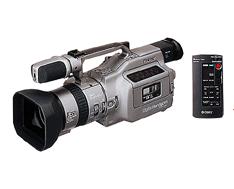|
ON THIS PAGE:
Why you need one
Tips
Steady shot
Hand held
|
 PART
4: TRIPODS PART
4: TRIPODS
by Christina
Fox
Steady shots are essential to make your pictures look
professional and keep you friendly with the picture editor. Wobbly pictures
limit the editors choice of usable shots and are difficult to edit into
and out of. With the Prosumer cameras you have the STEADY SHOT
facility which compensates for camera shake but does not eliminate it.
The steady shot feature does NOT replace the tripod.
|
WITH A TRIPOD YOU CAN...
- Take steadier shots every time, especially at the narrow angle end
of the lens.
- Ensure smoother camera movement (panning, tilting and pivoting).
- Keep the camera level by use of the spirit level.
The disadvantage is that it will take you a little longer
to set up the equipment, but at least all your shots will look better
for it.
Back to the top
|
TIPS ON USING THE TRIPOD
- Make sure the legs of the tripod are spread out as far as they will
go. This makes it as stable as possible.
- However, for safety you can use a tripod as a monopod by bringing
all the legs up together. This way no-one will trip over it in a scrum.
- Check the spirit level every time you move the tripod.
- Set the pan and tilt frictionís so that they are about equal.
- How much friction is personal preference - However, too little and
shots will still wobble - too much and you'll be fighting with your
tripod for control of the shot!
- Adjust the panning handle so that it is comfortable for you to use.
Again personal preference - but usually just on the droopy side of horizontal.
Back to the top
|
STEADY SHOT
Hand held work takes a lot of practice and is easier
for professional camera operators as the extra weight of the broadcast
camera gives it some stability. The very light domestic cameras are easily
affected by body movements, such as breathing in and out! However, there
will be times when it is impractical to use the tripod e.g. in a crowded
area. Use the steady shot feature.
Back to the top
|
IF YOU HAVE TO USE THE CAMERA HAND HELD...
- Use the wider lens angles whenever possible (Narrow angle shots will
accentuate camera shake)
- Try and brace yourself against a solid object like a wall, street
lamp or a car.
- Stand with your feet slightly apart to steady yourself.
- Breath slowly and gently.
©
2000 - 2010 Back to the top
|
- Move on to...
- Part 5: LIGHTING
- Or back to...
- Part 3: BATTERIES AND TAPES
|
|
|
|
Christina Fox
|

